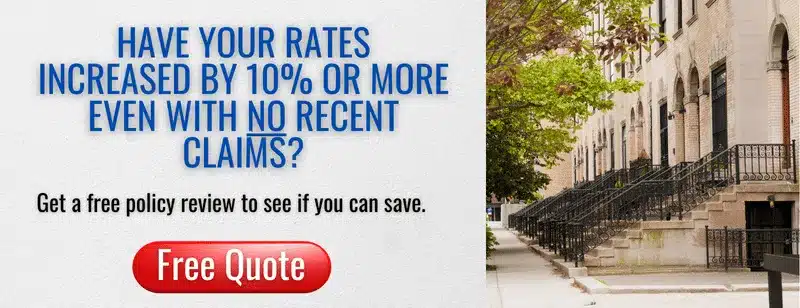The Consequences of Underinsuring Your NYC Property

Do you have the right amount of insurance coverage for your needs? From time to time, we speak with building owners in the New York City area whose properties are drastically underinsured. They pay lower premiums but receive an unpleasant surprise if they have a claim.
While property values in New York City have fluctuated in recent years, limited availability continues to drive demand and value. In Park Slope, an average brownstone building costs more than $4 million. The average townhome in Manhattan sells for $7.6 million, with a median sales price of $5.8 million. Building owners who purchased their property years ago may be drastically underinsured if their insurance company didn’t keep their policy up to date.
Understanding the Risk of Underinsurance
Nationwide Insurance estimates that roughly two out of every three homes in the United States are underinsured. On average, the underinsurance amount is around 22%, but some properties are underinsured by 60%—or even more. With climate change contributing to an increase in natural disasters, it’s more important than ever to make sure your insurance policy will provide adequate protection from a catastrophic loss.
The dangers of underinsurance are severe, ranging from financial loss and legal liability to a decrease in property value.
Financial Loss
The primary issue with underinsurance is the risk of significant financial loss. Without adequate insurance coverage, many owners cannot afford to restore their property to its original condition at the time of loss.
Keep in mind that insurance value has nothing to do with market value, which is the amount a buyer would pay for a home, including the land. Insurance value, by contrast, covers the costs necessary to repair or rebuild the entire building. Replacement costs are influenced by the cost of construction materials and the current labor market. Other considerations include architectural details and unique building materials, as in the case of brownstones and other historic buildings.
If you’re one of the lucky homeowners in East Brooklyn whose townhome value soared from, say, $800K to $1.6 million but your building insurance policy has only increased to $900K, you would be significantly underinsured—even for a partial loss. Many policies include an average clause or underinsurance clause, which reduces the payout for underinsured properties.
Legal Complications
Even property owners who purchase “extended replacement coverage” can find themselves underinsured. These policies typically increase the dwelling limits by a certain percentage, from 5% to 25%. If the property is significantly underinsured, this cushion may be insufficient. An article in the California Western Law Review referenced a homeowner who had a dwelling replacement limit of $358,195 with an “extended coverage” provision that increased the limit to $429,834. Unfortunately, the actual replacement cost was $782,000, a difference of more than $350,000.
Many property owners have sued their insurance companies in these situations, as was the case for another homeowner whose “replacement coverage” left her underinsured by more than $350,000, reported in the same article. The court ruled in favor of the insurance company, which had altered the policy terms by limiting payouts and provided “clearly worded notice” of the change. In addition, the company had sent yearly reminders that policy limits may be “significantly different” than actual replacement costs—and that it was the property owner’s responsibility to ensure adequate coverage.
Impact on Building Value
Reduced payouts due to underinsurance will have a negative impact on recovery. Perhaps this means replacing pre-war architectural features in a brownstone with less expensive, modern materials. In a total loss, the replacement structure might be smaller, using builder-grade cabinets and flooring in place of custom cabinetry and natural hardwood. Consequently, the restored property will have a lower building value than the original.
Strategies to Avoid Underinsurance
The best strategy to avoid underinsurance is to find the right insurance partner. Having an insurance expert work on your behalf will ensure that you have the right amount of coverage, including supplemental coverage that addresses special situations unique to you. Do you own fine art, jewelry or other high-value collectibles? You’ll probably want an insurance rider to cover these items. If you own a two-family brownstone and rent out the second unit, you’ll need landlord insurance as well as homeowner coverage.
The following guidance can also help you avoid underinsurance.
Understanding Replacement Costs
The replacement cost of a building is an estimate of how much it would cost to completely replace the structure if it were destroyed by a catastrophic event, such as a fire or natural disaster. This number considers such factors as age, square footage, and type/quality of building materials. For instance, the replacement cost for two similar brownstones could vary significantly if one featured original woodwork and architectural details and the other sported a contemporary interior with modern materials.
Also, replacement costs can change dramatically from year to year, based on prevailing labor and construction costs in the area. In the aftermath of the pandemic, for instance, construction costs skyrocketed due to shortages of labor and building materials. An experienced insurance partner will help you determine the appropriate level of replacement cost coverage when buying your policy and guide you at renewal time to ensure that your policy keeps up with current market conditions.
Regular Insurance Reviews
To help your insurance partner help you, it’s a good idea to review your insurance policy at least once a year with your agent or broker. This review should address inflation rates and other factors specific to your area, such as prevailing replacement costs. This is also an excellent time to discuss any property improvements or other changes. Upgrades often increase the amount of coverage you need, but some improvements—like a new roof or an updated electrical system—lower your risk and may qualify for discounts.
If the property under review includes rental units, this annual meeting is also a good time to update rent rolls to keep Loss of Rents coverage current.
Keep Your Building Insurance Coverage Current
In addition to annual reviews, you should contact your agent or broker any time something significant happens that could affect your policy. For example, if the name on the deed changes, contact your insurance partner immediately to avoid any delays in case of a claim. Property upgrades and new purchases should also be reported to your insurance partner promptly to avoid gaps in coverage. Make it a practice to notify your insurance partner of any changes, and you can rest easy, knowing that you really are protected.
If you have questions about your insurance coverage or think you may be underinsured, call us at 877-576-5200 for a complimentary, no-obligation policy review.

